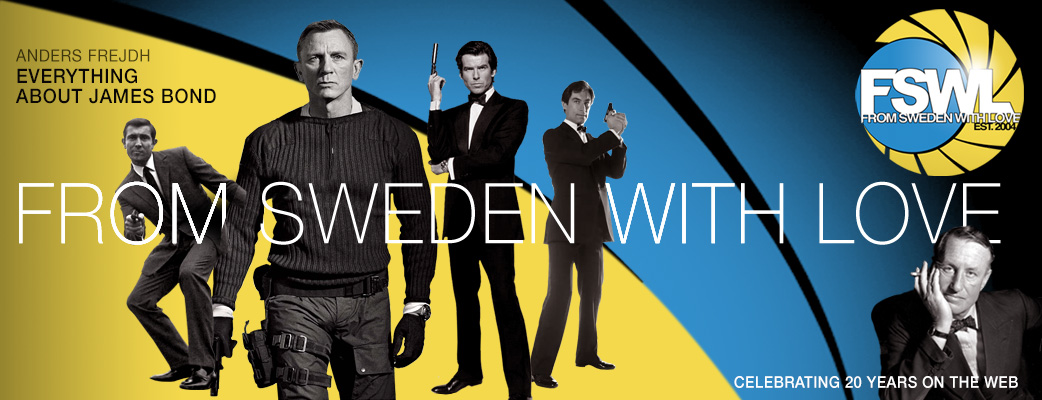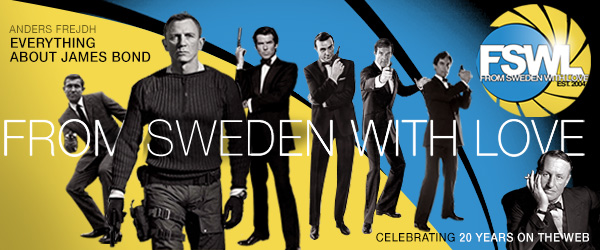Website last updated: 21-3-2024
Home
Book & Film reviews
Competitions
FSWL Merchandise
In Memoriam
Interviews
James Bond 007 articles
James Bond 007 collection
James Bond 007 films
James Bond 007 games
James Bond 007 literature
James Bond 007 news
James Bond 007 products
James Bond 007 shop
James Bond 007 stars
James Bond Fan Clubs
Swedes in the Bond films
Birthday of James Bond actor Timothy Dalton
By: Anders Frejdh
Published:
2018-03-21
2018-03-21
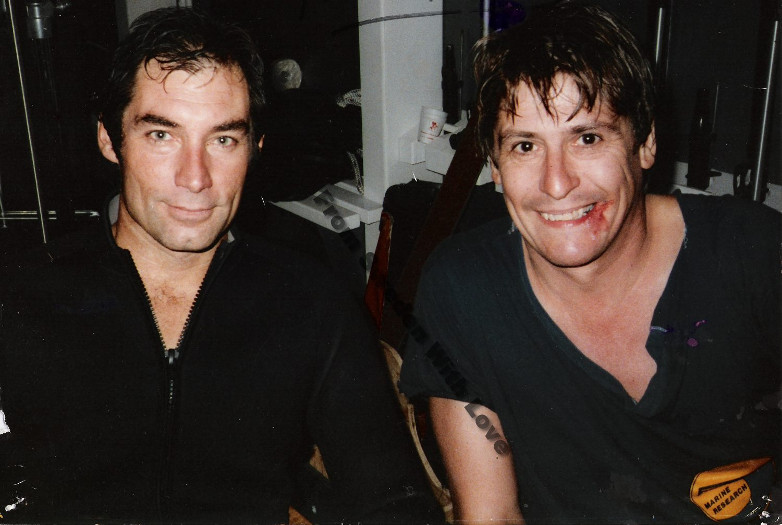
With this page, FSWL would like to celebrate the talented actor who came close to Ian Fleming's original literary hero in his portrayal of 007.
"Happy birthday Timothy and keep up the great work, you have really rocked our world. Warm regards from Sweden. With love."
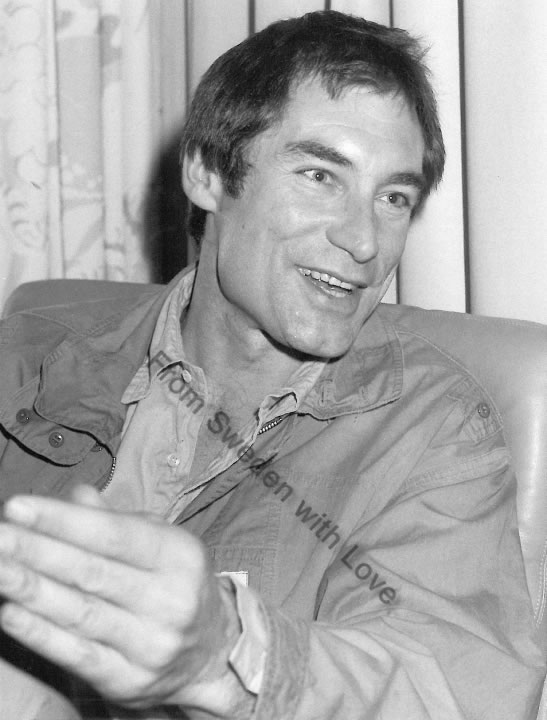
Timothy Dalton in Stockholm 1987 to promote The Living Daylights. From FSWL's private collection.
Director John Glen remembers the casting of Timothy and his work:
"Timothy had been approached previously when he was a rising young star with films like The Lion in Winter and Wuthering Heights. His acting credentials were impeccable. We invited him to a meeting and convinced him this time to take the role.
It was essential and agreed with Timothy that he would be his own man as Bond. The intention was to bring a harder edge to the character and take full advantage of his considerable acting talents. To be up-to-date and retain the essential Bond humour. Again Tim was a terrific professional."
"In my eyes, Timothy is poetry in motion." - Virginia Hey (Rubavich in The Living Daylights)
About James Bond actor Timothy Dalton
Timothy Dalton was born 1944 in Colwyn Bay, North Wales to an American mother of Italian and Irish descent and an English father, who was a captain in the Special Operations Executive during World War II and had become an advertising executive at the time of his son's birth. Before his fourth birthday, the family moved to Belper, Derbyshire. While in Belper, he attended the Herbert Strutt Grammar School. As a teenager, he was a member of the Air Cadets but at age 16 saw Macbeth and Dalton's life changed. He left school in 1964 to enrol in the Royal Academy of Dramatic Art (RADA) and tour with the National Youth Theatre. Dalton did not complete his RADA studies, leaving the academy in 1966 to join the ensemble of the Birmingham Repertory Theatre.
Dalton quickly moved to television, working mainly with BBC and, in 1968, made his film debut as Philip II of France in The Lion in Winter. This was the first of several period dramas, which included a remake of Wuthering Heights in 1970 in which he portrayed the tortured Heathcliff. In 1968, Albert R. Broccoli asked the 22-year-old Dalton to take over for Sean Connery in the role of James Bond. This would not be the last time Dalton turned the role down. After a few more films, Dalton took a break in 1971 to concentrate on the theatre, performing with the Royal Shakespeare Company and other troupes throughout the world.
With two notable exceptions, the films Mary, Queen of Scots (1972) Permission to Kill (1975), he remained a theatre actor until 1978. That year he starred in Sextette as the husband of 85-year-old Mae West, hailing his return to cinema and the beginning of his American career. While in the United States, Dalton worked mainly in television, although he starred in several films. During this time, he played Prince Barin in the 1980 cult science fiction classic Flash Gordon and played Mr. Rochester in the 1983 BBC serial of Jane Eyre. He also co-starred with Joan Collins in the miniseries, Sins (1986).
In 1986, Dalton was the first choice to replace the retiring Roger Moore, but obligations to the film Brenda Starr and the stage productions of Antony and Cleopatra and The Taming of The Shrew kept him from accepting the role. Sam Neill was then screen-tested for the part of Bond, but was ultimately rejected by Albert R. Broccoli. Pierce Brosnan was then approached for the role, but was forced by NBC to turn it down (after initially accepting it) because of his contractual commitments to the television series Remington Steele. By this time, when Dalton completed the filming of Brenda Starr, he was now available to assume the role as James Bond.
Previously, Dalton had been considered for the role of James Bond four times. In 1968, he was asked to play Bond in On Her Majesty's Secret Service (1969) after Sean Connery decided that You Only Live Twice (1967) would be his last Bond film. Dalton turned the offer down, feeling he was too young for the role; it finally went to George Lazenby. In a 1987 interview, Dalton said:
"Originally I did not want to take over from Sean Connery. He was far too good, he was wonderful. I was about 24 or 25, which is too young. But when you've seen Bond from the beginning, you don't take over from Sean Connery."
During the late-1970s, he was approached again, but he did not favour the direction the movies were taking. As he explained, his idea of Bond was different. In a 1979 episode of the television series Charlie's Angels, Dalton played the role of Damien Roth, a millionaire playboy described by David Doyle's character as "almost James Bond-ian", either an amusing coincidence, or a specific in-joke, since it was around that time that Dalton was also asked to star in For Your Eyes Only (1981).
Dalton's first appearance as 007 in The Living Daylights was critically successful, and grossed more than the previous two Bond films with Moore, as well as contemporary box-office rivals such as Die Hard and Lethal Weapon. However, his second film, Licence to Kill, although almost as successful as its predecessor in most markets, did not perform as well at the U.S. box office, in large part due to a lacklustre marketing campaign, after the title of the film was abruptly changed from Licence Revoked. MGM executives believed that takings would be harmed due to most Americans not knowing what the word "revoked" meant. However, the main factor for the lack of success in the U.S. was that it was released at the same time as the hugely successful Indiana Jones and the Last Crusade, Tim Burton┬┤s Batman, and Lethal Weapon 2, during the summer blockbuster season. Future Bond films, following the resolution of legal and other issues, were all released between 31 October and after mid December, in order to avoid the risk of a summer failure, as had happened to Licence to Kill.
With a worldwide gross of 191 million dollar, The Living Daylights became the fourth most successful Bond film at the time of its release. In 1998 the second Deluxe Edition of Bond's Soundtracks was released. The Living Daylights was one of the first soundtracks to receive deluxe treatment. The booklet/poster of this CD contains MGM's quote about The Living Daylights being the fourth most successful Bond film.
Since Dalton was contracted for three Bond films, the pre-production of his third film began in 1990, in order to be released in 1991. It was rumoured that he would make The Property of a Lady which is one of Ian Fleming's short stories in Octopussy and The Living Daylights (1966) and elements of which had been included in Octopussy (1983) (1983), but this was never confirmed. What was confirmed is that the story would deal with the destruction of a chemical weapons laboratory in Scotland, and the events would take place in London, Tokyo and Hong Kong. However, the film was cancelled due to legal issues between UA/MGM and EON, which lasted for four years.
The legal battle ended in 1993, and Dalton was expected to return as James Bond in the next Bond film, which later became GoldenEye (1995). Despite his contract having expired, negotiations with him to renew it took place. In an interview with the Daily Mail in August 1993, Dalton indicated that Michael France was writing the screenplay for the new film, and the production was to begin in January or February 1994. When the deadline was not met, Dalton surprised everyone on 12 April 1994 with the announcement that he would not return as James Bond. At this time, he was shooting the mini-series Scarlett. The announcement for the new Bond came two months later, with Pierce Brosnan playing the role. Dalton reflected in 2007, "I was supposed to make one more but it was cancelled because MGM and the film's producers got into a lawsuit which lasted for five years. After that, I didn't want to do it anymore."
Unlike Moore, who had played Bond as more of a light-hearted playboy and admitted that he had read very little Fleming and found the books lacking in humour, Dalton's portrayal of Bond was darker, stiffer and more serious. Dalton pushed for renewed emphasis on gritty realism instead of fantasy plots and humour. Dalton stated in a 1989 interview:
"I think Roger was fine as Bond, but the movies had become too much techno-pop and had lost track of their sense of story. I mean, every movie seemed to have a villain who had to rule or destroy the world. If you want to believe in the fantasy on screen, then you have to believe in the characters and use them as a stepping-stone to lead you into this fantasy world. That's a demand I made, and Cubby Broccoli agreed with me.ŌĆØ
A fan of the literary character, often seen re-reading and referencing the novels on set, Dalton determined to approach the role and play truer to the original character described by Fleming. His 007, therefore, came across as a reluctant agent who did not always enjoy the assignments he was given, something only seen on screen before, albeit obliquely, in George Lazenby's On Her Majesty's Secret Service. In The Living Daylights, for example, Bond tells a critical colleague, "Stuff my orders! ... Tell M what you want. If he fires me, I'll thank him for it." In Licence to Kill, he resigns the Secret Service in order to pursue his own agenda of revenge. Stephen Jay Rubin writes in The Complete James Bond Movie Encyclopaedia:
ŌĆ£Unlike Moore, who always seems to be in command, Dalton's Bond sometimes looks like a candidate for the psychiatristŌĆÖs couches ŌĆö a burned-out killer who may have just enough energy left for one final mission. That was Fleming's Bond ŌĆö a man who drank to diminish the poison in his system, the poison of a violent world with impossible demands.... His is the suffering Bond.ŌĆØ
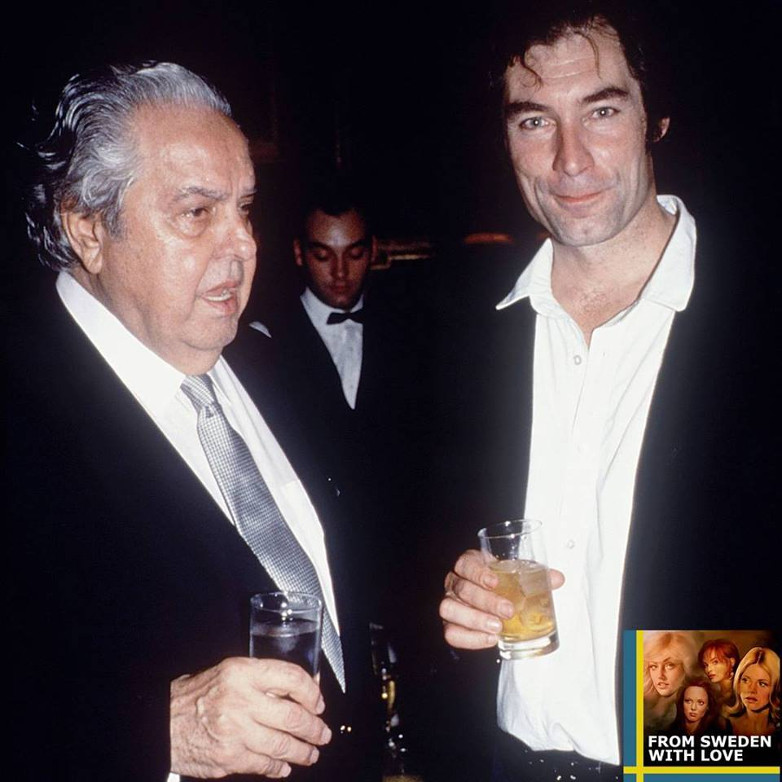
Timothy Dalton & Bond producer Albert R. Broccoli at the premiere of Licence to Kill in London, June 1989. Photo from FSWL's private archives.

Timothy Dalton, Carey Lowell, Talisa Soto & Robert Davi at Mayfair Hotel in London 1989 for the premiere of Licence to Kill. Photo by Doreen Volte. From FSWL's private collection.
This approach proved to be a double-edged sword. Film critics and fans of Fleming's original novels welcomed a more serious interpretation after more than a decade of Moore's approach. However, Dalton's films were criticized by many for their comparative lack of humour. Dalton's serious interpretation was not only in portraying the character, but also in performing most of the stunts of the action scenes himself.
After his Bond films, Dalton divided his work between stage, television and films, and diversified the characters he played. This helped him eliminate the 007 typecasting that followed him during the previous period. Dalton was nevertheless for a certain period considered to return as 007 in GoldenEye. Instead, he played the villainous matinee idol Neville Sinclair in The Rocketeer (1991), and Rhett Butler in Scarlett, the television miniseries sequel to Gone with the Wind. He also appeared as criminal informant Eddie Myers in the acclaimed 1992 British miniseries "Framed".
During the second half of the 1990s he starred in several cable films, most notably the Irish Republican Army drama, The Informant, and the action thriller Made Men. In the 1999 TV film Cleopatra he played Julius Caesar.
In 2003, he played a parody of James Bond named Damian Drake in the film Looney Tunes: Back in Action. At the end of that year and the beginning of 2004, he returned to theatre to play Lord Asriel in the stage version of His Dark Materials. In 2007, Dalton played Simon Skinner in the action/comedy film Hot Fuzz.
Dalton returned once again to British television in a guest role for the Doctor Who 2009/10 two-part special "The End of Time'ŌĆÖ, playing Rassilon.
In 2010, Dalton voiced the character Mr. Pricklepants in Toy Story 3. The same year he appeared in The Tourist (2010) with Steven Berkoff (General Orlov i Octopussy).
TV roles:
2014-2015: Penny Dreadul (Sir Malcolm)
2010-2011: Chuck (Alexei Volkoff / Gregory Tuttle)
2009-2010: Doctor Who (Lord President Rassilon)
2008: Unknown Sender (Miles)
1999: Cleopatra (Julius Caesar)
1998: Stories from My Childhood (Prince Gvidon)
1994: Scarlett (Rhett Butler)
1992: Framed (Eddie Myers)
1992: Tales from the Crypt (Lokai)
1986: Sins (Edmund Junot)
1985: Faerie Tale Theatre (Narrator)
1984: Mistral's Daughter (Perry Kilkullen)
1983: Jane Eyre (Edward Fairfax Rochester)
1981: Dynasty (Guest at Party)
1979: Charlie's Angels (Damien Roth)
1978-1979: Centennial (Oliver Seccombe)
1970-1971: BBC Play of the Month (Clive Harrington / Marchbanks)
1967: Sat'day While Sunday (Peter)
Timothy Dalton currently lives in Los Angeles with his son Alexander. In his spare time, he enjoys fishing, reading, listening to jazz and opera, go to antique fairs and auctions, and watch movies.
Birthdays for other James Bond film actors on From Sweden With Love:
>Barry Nelson (April 16)
>Bob Holness (November 12)
>Daniel Craig (March 2)
>George Lazenby (September 5)
>Pierce Brosnan (May 16)
>Roger Moore (October 14)
>Sean Connery (August 25)
Photo on top:
Timothy Dalton with Swedish stuntman Lars Lundgren during the filming of Licence to Kill in Mexico. Photo from FSWL's private collection.
For information about Timothy Dalton's film career, check out his profile on IMDB.
Tags:
#birthdays
#james_bond
#timothy_dalton
Tweet
